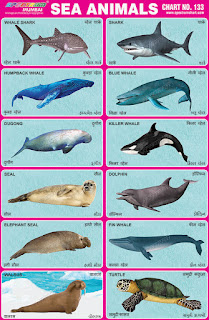 |
| Sea Animals Chart |
Spectrum Chart - 133 : Sea Animals
- Whale Shark – The Whale Shark, is a large filter feeding shark, and is the largest shark in the world, reaching lengths of up to 12 metres long and weighing as much as 47,000 pounds. The Whale shark has a very wide distribution, found in all tropical and warm temperate seas. The life span of the whale shark ranges from 60 to 100 years.
- Shark - There are more than 350 different kinds of sharks. Sharks come in many different shapes and sizes, but most are long and thin, with powerful jaws. Their teeth are constantly replaced throughout their lives.
- Humpback Whale – Humpback Whale is a large baleen whale with long flippers and a knobbly head. They can be found in every ocean. They can grow to 15–16 m (49–52 ft) long and weigh up to 40 metric tons. The male humpback whale is known to sing for up to 22 hours at a time. Their lifespan ranges from 45 to 100 years.
- Blue Whale - Blue Whale is a marine mammal belonging to the baleen whales. At 30 metres (98 ft) in length and up to 173 tonnes in weight, it is the largest extant animal and is the heaviest known to have existed. Blue whale's body is long and slender. Blue whales feed almost exclusively on krill, an adult blue whale can eat up to 40 million krill in a day.
- Dugong - Dugong is a large mammal that lives its whole life in the sea. They are sometimes called "sea cows" as they eat large amounts of sea grass. Dugong can grow to about 3m (10ft) long and weigh as much as 400 kg. They only come to the surface to breathe and they never come up on the land. The dugong can live for up to 70 years of age.
- Killer Whale - Killer Whales are cetaceans. They are the largest dolphins in the world, called 'whales' because of their size. Orca's have mostly black skin with white patches.They are found in all the world's oceans, from the cold of the Arctic to the tropical seas.
- Seal - Seal is of web-footed aquatic mammals that live chiefly in cold seas. Seals are carnivores, eating mainly fish, though some also consume squid, other mollusks, and crustaceans. Seals have been hunted for their meat, hides, oil and fur.
- Dolphin – Dolphins are aquatic marine mammals part of the toothed whales. Dolphins are from 1.5 to 4 metres long. Although dolphins are widespread, most species prefer the warmer waters of the tropic zones. Dolphins feed largely on fish and squid. Dolphins are often regarded as one of Earth's most intelligent animals.
- Elephant Seal - Elephant Seal is a huge seal of the genus Mirounga. The elephant seal is the largest amphibious animal. There are two species, one in each hemisphere. The southern elephant seal, is found in Antarctic waters, while the northern elephant seal lives on islands of California and Mexico.
- Fin Whale - Fin whale is also called finback whale, razorback whale or common rorqual, a slender baleen whale, second in size to the blue whale. The fin whale is 18–27 metres (59–89 feet) long, with short baleen and has 56–100 grooves along its throat and chest. It is found worldwide in all the oceans.
- Walrus – A walrus is a marine mammal, the only species of the family Odobenidae. They live in the cold northern seas around North America & Europe. The most famous thing about walruses are their tusks. Even though they are called tusks, they are actually teeth growing out of their mouth. Walruses can change colour depending on how warm they are. They are usually different kinds of brown, but as they get warmer, their skin can turn pink.
- Sea Otter - Sea Otter is a marine mammal native to the coasts of the northern and eastern North Pacific Ocean. Adult sea otters typically weigh between 14 and 45 kg. Sea otters have about 26,000 to 165,000 hairs per square centimeters of skin. They have a rich fur for which humans hunted them almost to extinction.

No comments:
Post a Comment